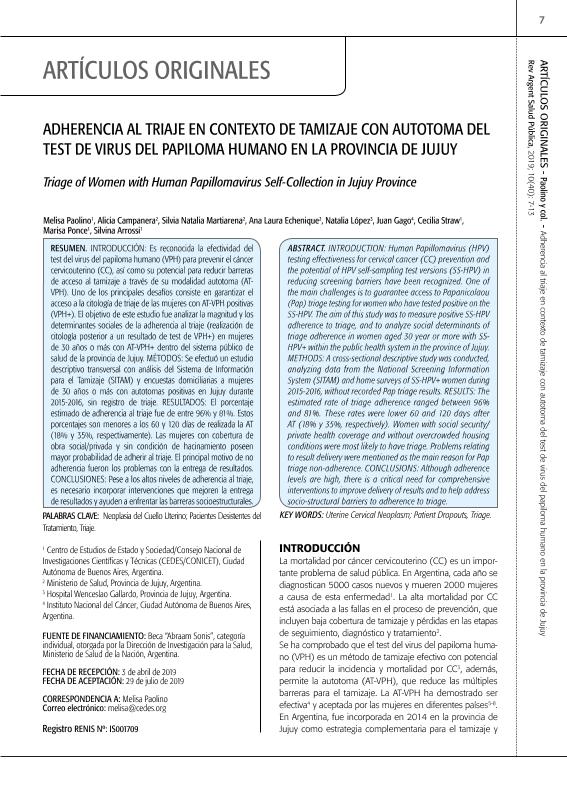Mostrar el registro sencillo del ítem
dc.contributor.author
Paolino, Melisa Delia

dc.contributor.author
Campanera, Alicia

dc.contributor.author
Martiarena, Silvia Natalia

dc.contributor.author
Echenique, Alfonsina

dc.contributor.author
Lopez, Natalia

dc.contributor.author
Gago, Juan Ezequiel

dc.contributor.author
Straw, Cecilia

dc.contributor.author
Ponce, Marisa

dc.contributor.author
Arrossi, Silvina

dc.date.available
2021-05-01T01:45:08Z
dc.date.issued
2019-09
dc.identifier.citation
Paolino, Melisa Delia; Campanera, Alicia; Martiarena, Silvia Natalia; Echenique, Alfonsina; Lopez, Natalia; et al.; Adherencia al triaje en contexto de tamizaje con autotoma del test de virus del papiloma humano en la provincia de Jujuy; Ministerio de Salud de la Nación; Revista Argentina de Salud Pública; 10; 40; 9-2019; 7-13
dc.identifier.issn
1852-8724
dc.identifier.uri
http://hdl.handle.net/11336/131201
dc.description.abstract
INTRODUCCIÓN: Es reconocida la efectividad del test del virus del papiloma humano (VPH) para prevenir el cáncer cervicouterino (CC), así como su potencial para reducir barreras de acceso al tamizaje a través de su modalidad autotoma (ATVPH). Uno de los principales desafíos consiste en garantizar el acceso a la citología de triaje de las mujeres con AT-VPH positivas (VPH+). El objetivo de este estudio fue analizar la magnitud y los determinantes sociales de la adherencia al triaje (realización de citología posterior a un resultado de test de VPH+) en mujeres de 30 años o más con AT-VPH+ dentro del sistema público de salud de la provincia de Jujuy. MÉTODOS: Se efectuó un estudio descriptivo transversal con análisis del Sistema de Información para el Tamizaje (SITAM) y encuestas domiciliarias a mujeres de 30 años o más con autotomas positivas en Jujuy durante 2015-2016, sin registro de triaje. RESULTADOS: El porcentaje estimado de adherencia al triaje fue de entre 96% y 81%. Estos porcentajes son menores a los 60 y 120 días de realizada la AT (18% y 35%, respectivamente). Las mujeres con cobertura de obra social/privada y sin condición de hacinamiento poseen mayor probabilidad de adherir al triaje. El principal motivo de no adherencia fueron los problemas con la entrega de resultados. CONCLUSIONES: Pese a los altos niveles de adherencia al triaje, es necesario incorporar intervenciones que mejoren la entrega de resultados y ayuden a enfrentar las barreras socioestructurales.
dc.description.abstract
INTRODUCTION: Human Papillomavirus (HPV) testing effectiveness for cervical cancer (CC) prevention and the potential of HPV self-sampling test versions (SS-HPV) in reducing screening barriers have been recognized. One of the main challenges is to guarantee access to Papanicolaou (Pap) triage testing for women who have tested positive on the SS-HPV. The aim of this study was to measure positive SS-HPV adherence to triage, and to analyze social determinants of triage adherence in women aged 30 year or more with SSHPV+ within the public health system in the province of Jujuy. METHODS: A cross-sectional descriptive study was conducted, analyzing data from the National Screening Information System (SITAM) and home surveys of SS-HPV+ women during 2015-2016, without recorded Pap triage results. RESULTS: The estimated rate of triage adherence ranged between 96% and 81%. These rates were lower 60 and 120 days after AT (18% y 35%, respectively). Women with social security/ private health coverage and without overcrowded housing conditions were most likely to have triage. Problems relating to result delivery were mentioned as the main reason for Pap triage non-adherence. CONCLUSIONS: Although adherence levels are high, there is a critical need for comprehensive interventions to improve delivery of results and to help address socio-structural barriers to adherence to triage
dc.format
application/pdf
dc.language.iso
spa
dc.publisher
Ministerio de Salud de la Nación
dc.rights
info:eu-repo/semantics/openAccess
dc.rights.uri
https://creativecommons.org/licenses/by-nc/2.5/ar/
dc.subject
Neoplasia del Cuello Uterino
dc.subject
Pacientes Desistentes del Tratamiento
dc.subject
Triaje
dc.subject.classification
Salud Pública y Medioambiental

dc.subject.classification
Ciencias de la Salud

dc.subject.classification
CIENCIAS MÉDICAS Y DE LA SALUD

dc.title
Adherencia al triaje en contexto de tamizaje con autotoma del test de virus del papiloma humano en la provincia de Jujuy
dc.title
Triage of Women with Human Papillomavirus Self-Collection in Jujuy Province
dc.type
info:eu-repo/semantics/article
dc.type
info:ar-repo/semantics/artículo
dc.type
info:eu-repo/semantics/publishedVersion
dc.date.updated
2021-04-22T20:08:34Z
dc.identifier.eissn
1853-810X
dc.journal.volume
10
dc.journal.number
40
dc.journal.pagination
7-13
dc.journal.pais
Argentina

dc.journal.ciudad
Buenos Aires
dc.description.fil
Fil: Paolino, Melisa Delia. Centro de Estudios de Estado y Sociedad; Argentina. Consejo Nacional de Investigaciones Científicas y Técnicas; Argentina
dc.description.fil
Fil: Campanera, Alicia. Gobierno de la Provincia de Jujuy. Ministerio de Salud; Argentina
dc.description.fil
Fil: Martiarena, Silvia Natalia. Gobierno de la Provincia de Jujuy. Ministerio de Salud; Argentina
dc.description.fil
Fil: Echenique, Alfonsina. Gobierno de la Provincia de Jujuy. Ministerio de Salud; Argentina
dc.description.fil
Fil: Lopez, Natalia. Hospital Wenceslao Gallardo; Argentina
dc.description.fil
Fil: Gago, Juan Ezequiel. Instituto Nacional del Cáncer; Argentina
dc.description.fil
Fil: Straw, Cecilia. Centro de Estudio de Estado y Sociedad; Argentina
dc.description.fil
Fil: Ponce, Marisa. Centro de Estudio de Estado y Sociedad; Argentina. Comisión Nacional de Investigación Científica y Tecnológica; Chile
dc.description.fil
Fil: Arrossi, Silvina. Centro de Estudio de Estado y Sociedad; Argentina. Comisión Nacional de Investigación Científica y Tecnológica; Chile
dc.journal.title
Revista Argentina de Salud Pública
dc.relation.alternativeid
info:eu-repo/semantics/altIdentifier/url/http://rasp.msal.gov.ar/indice-msal.asp?id=69
Archivos asociados
